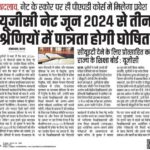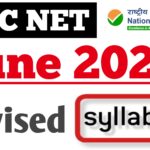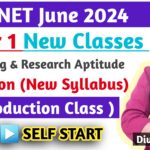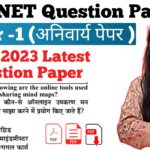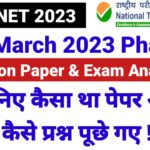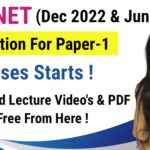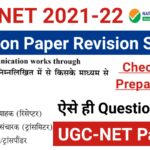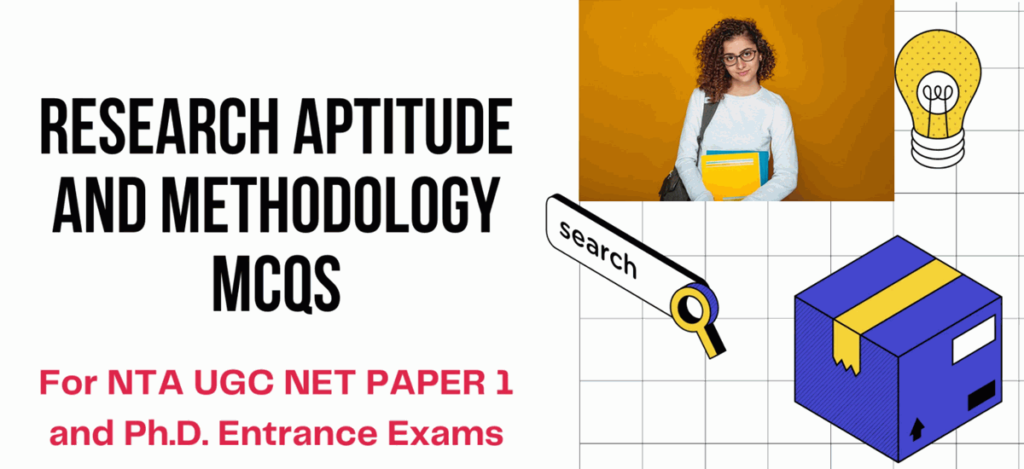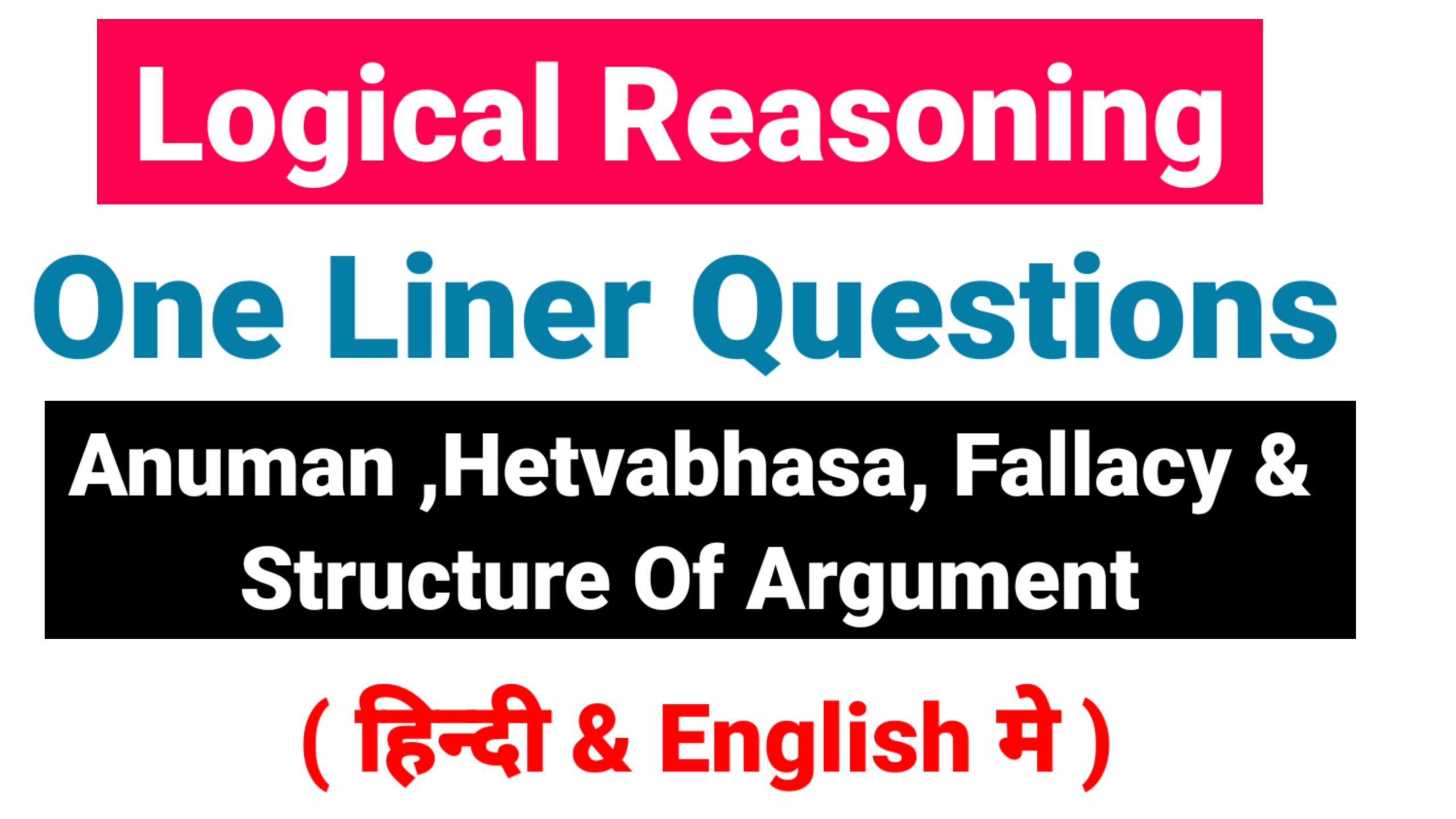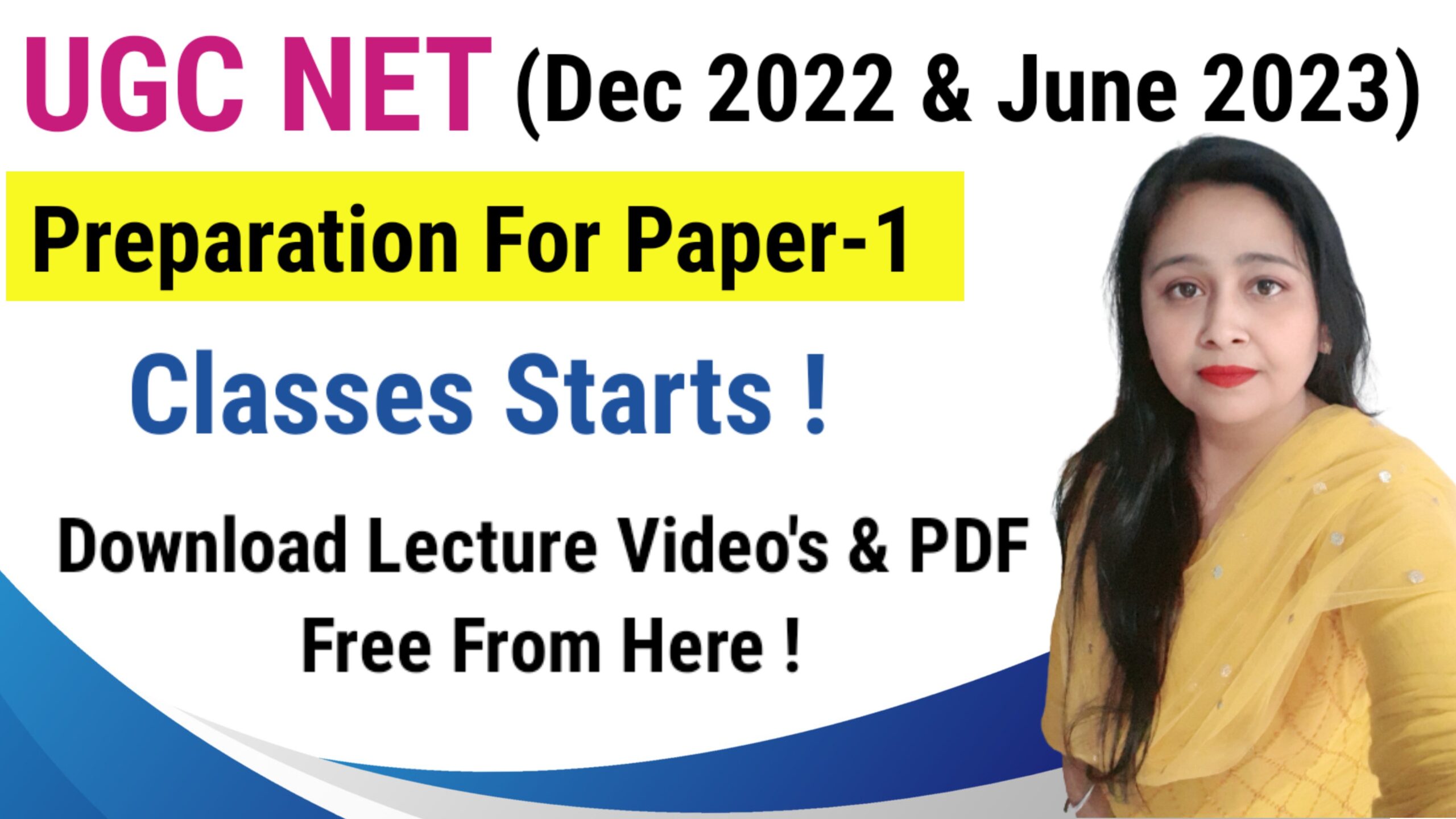
Below is the list of MCQ & Some Important Question-Based UGC NET JRF Exam – Paper 1: Research Aptitude. For Practice please go through these 500 + Research Aptitude Practice MCQ & Answers. This will help to understand the nature and pattern of question coming in the examination.
- Who authored the book “methods in Social Research”
a) Wilkinson b) CR Kothari c) Ker linger d) Goode and Halt - “Research is an organized and systematic enquiry” Defined by
a) Marshall b) P.V. Young c) Emory d) Ker linger - Research is a “Scientific undertaking” opined by
a) Young b) Kerlinger c) Kothari d) Emory - “A systematic step-by-step Procedure following logical process of reasoning” called
a) Experiment b) Observation c) Deduction d) Scientific method - Ethical Neutrality is a feature of
a) Deduction b) Scientific method c) Observation d) experience - Scientific method is committed to ……………….
a) Objectivity b) Ethics c) Proposition d) Neutrality - “One of the methods of logical reasoning process” is called
a) Induction b) Deduction c) Research d) Experiment
School of Distance Education
Research Methodology Page 2 - An essential Criterion of Scientific study is
a) Belief b) Value c) Objectivity d) Subjectivity - “Reasoning from general to particular “is called
a) Induction b) deduction c) Observation d) experience - “Deduction and induction are a part of system of reasoning” – stated by
a) Caroline b) P.V.Young c) Dewey John d) Emory
See Also
- “ A system of systematically interrelated concepts definitions and propositions that
are advanced to explain and predict phenomena” … is
a) Facts b) Values c) Theory d) Generalization - “ A system of systematically interrelated concepts, definitions and propositions that
are advanced to explain and Predict phenomena” defined by
a) Jack Gibbs b) PV Young c) Black d) Rose Arnold - Theory is “ a set of systematically related propositions specifying casual relationship
among variables” is defined by
a) Black James and Champion b) P.V. Young
c) Emory d) Gibbes - “Empirically verifiable observation” is
a) Theory b) Value c) Fact d) Statement - Fact is “empirically verifiable observation” — is defined by
a) Good and Hatt b) Emory c) P.V. Young d) Claver - ……….. is “systematically conceptual structure of inter related elements in some
schematic form”
a) Concept b) Variable c) Model d) Facts - Social Science deals with ………..
a) Objects b) Human beings c) Living things d) Non living things - Science is broadly divided into ……………….
a) Natural and Social b) Natural and Physical
c) Physical and Mental d) Social and Physical - Social Science try to explain …………. Between human activities and natural laws
governing them
a) Causal Connection b) reason
c) Interaction d) Objectives
School of Distance Education
Research Methodology Page 3 - Social Science Research ……………. Problems
a) Explain b) diagnosis c) Recommend d) Formulate - Social research aims at ……………….
a) Integration b) Social Harmony
c) National Integration d) Social Equality - The method by which a sample is chosen
a) Unit b) design c) Random d) Census - Basing conclusions without any bias and value judgment is ……………
a) Objectivity b) Specificity c) Values d) Facts
SEE ALSO
Ugc Net Previous Year Question Paper
- Research is classified on the basis of …….. and methods
a) Purpose b) Intent c) Methodology d) Techniques - Research undertaken for knowledge sake is
a) Pure Research b) Action Research c) Pilot study d) Survey - Example for fact finding study is
a) Pure Research b) Survey
c) Action Research d) Long term Research - Facts or information’s are analyzed and critical evaluation is made in
a) Survey b) Action research
c) Analytical research d) Pilot study - Research conducted to find solution for an immediate problem is ………….
a) Fundamental Research b) Analytical Research
c) Survey d) Action Research - Fundamental Research is otherwise called
a) Action Research b) Survey c) Pilot study d) Pure Research - Motivation Research is a type of …………… research
a) Quantitative b) Qualitative c) Pure d) applied - Research related to abstract ideas or concepts is
a) Empirical research b) Conceptual Research
c) Quantitative research d) Qualitative research - A research which follows case study method is called
a) Clinical or diagnostic b) Causal
c) Analytical d) Qualitative
School of Distance Education
Research Methodology Page 4 - Research conducted in class room atmosphere is called
a) Field study b) Survey
c) Laboratory Research d) Empirical Research - Research through experiment and observation is called
a) Clinical Research b) Experimental Research
c) Laboratory Research d) Empirical Research - Population Census is an example of ………….. Research
a) Survey b) Empirical c) Clinical d) Diagnostic - The author of “ The Grammar of Science” is
a) Ostle b) Richard c) Karl Pearson d) Kerlinger - “The Romance of Research” is authored by
a) Redmen and Mory b) P.V.Young c) Robert C meir d) Harold Dazier - ………….. is a way to systematically solve the research problem
a) Technique b) Operations
c) Research methodology d) Research Process - Good Research is always ……………
a) Slow b) Fast c) Narrow d) Systematic - Good research is ……………
a) Logical b) Non logical c) Narrow d) Systematic - “Criteria of Good Research” is written by
a) Delta Kappan b) James Harold Fox c) P.V.Young d) Karl Popper - Research method is a part of …………..
a) Problem b) Experiment
c) Research Techniques d) Research methodology - Identifying causes of a problem and possible solution to a problem is
a) Field Study b) diagnosis tic study
c) Action study d) Pilot study - ………… helps in social planning
a) Social Science Research b) Experience Survey
c) Problem formulation d) diagnostic study - “Foundations of Behavioral Research” is written by
a) P.V. Young b) Kerlinger c) Emory d) Clover Vernon
School of Distance Education
Research Methodology Page 5 - Methods and issues in Social Research” is written by
a) Black James and Champions b) P.V. Young
c) Mortan Kaplan d) William Emory - “Scientific Social Survey and Research” is written by
a) Best John b) Emory c) Clover d) P.V. Young - “Doubt is often better than ……………….”
a) Belief b) Value c) Confidence d) Overconfidence - Research help in explaining the ………… with which something operates.
a) Velocity b) Momentum c) Frequency d) gravity - …………… is a motivation for research in students
a) Research degree b) Research Academy
c) Research Labs d) Research Problems - Which of the following is an example of primary data?
a) Book b) Journal c) News Paper d) Census Report - Major drawback to researchers in India is …………….
a) Lack of sufficient number of Universities
b) Lack of sufficient research guides
c) Lack of sufficient Fund
d) Lack of scientific training in research - ICSSR stands for
a) Indian Council for Survey and Research
b) Indian Council for strategic Research
c) Indian Council for Social Science Research
d) Inter National Council for Social Science Research - UGC Stands for
a) University Grants Commission b) Union Government Commission
c) University Governance Council d) Union government Council - JRF is for
a) Junior Research Functions b) Junior Research Fellowship
c) Junior Fellowship d) None of the above - ………….. is the first step of Research process
a) Formulation of a problem b) Collection of Data
c) Editing and Coding d) Selection of a problem - A problem well put is ……………….
a) Fully solved b) Not solved c) Cannot be solved d) half- solved
School of Distance Education
Research Methodology Page 6 - ……………. is a source of problem
a) Schools and Colleges b) Class Room Lectures
c) Play grounds d) Infra structures - A question which requires a solution is ………….
a) Observation b) Problem c) Data d) Experiment - Converting a question into a Researchable problem is called …………
a) Solution b) Examination
c) Problem formulation d) Problem Solving - While Selecting a problem, problem which is ………….. is no taken
a) Very Common b) Overdone c) Easy one d) rare - The first step in formulating a problem is
a) Statement of the problem b) Gathering of Data
c) Measurement d)Survey - …………….. will help in finding out a problem for research
a) Professor b) Tutor c) HOD d) Guide - Second step in problem formulation is
a ) Statement of the problem
b) Understanding the nature of the problem
c) Survey
d) Discussions - Third step in problem formulation is
a) Statement of the problem
b) Understanding the nature of the problem
c) Survey the available literature
d) Discussion - Fourth step in problem formulation is
a) Develop ideas through discussion b) Survey
c) Statement of problem Enactment - Last step in problem formulation is
a) Survey b) Discussion
c) Literature survey d) Re Phrasing the Research problem - In the formulation of the problem we need to give a ………….
a) Title b) Index c) Bibliography d) Concepts - Objectives in problem formulation means
a) Questions to be answered b) methods
c) Techniques d)methodology
School of Distance Education
Research Methodology Page 7 - The problem selected must have
a) Speed b) Facts c) Values d) Novelty - The formulated problem should have
a) Originality b) Values c) Coherence d) Facts - The purpose of Social Science Research is
a) Academic and Non academic b) Cultivation
c) Academic d) Utilitarian - The Academic purpose is to have ……………….
a) Information b) firsthand knowledge
c) Knowledge and information d) models - Social Science Research creates Social ……………
a) Alienation b) Cohesion c) mobility d) Integration - ………… is a quality of Good Researcher
a) Scientific temper b) Age c) Money d) time - Social Science Research in India aims at a ………. State
a) Secular b) Totalitarian c) democratic d) welfare - A ……………… is an abstraction formed by generalization from particulars
a) Hypothesis b) Variable c) Concept d)facts - Concept is of two types
a) Abstract and Coherent b) Concrete and Coherent
c) Abstract and concrete d) None of the above - Concepts are of ……………….types
a) 4 b) 6 c) 10 d) 2 - There is a concept by ……………………
a) Observation b) formulation c) Theory d) Postulation - Another concept is by ………………..
a) Formulation c) Postulation c) Intuition d) Observation - Concepts are ……………. of Research
a)guide b) tools c)methods d) Variables - Concepts are ………………….
a)Metaphor b) Simile c) Symbols d) Models
School of Distance Education
Research Methodology Page 8 - Concepts represent various degree of ……………..
a) Formulation b) Calculation c) Abstraction d) Specification - Concepts which cannot be given operational definitions are ………… concepts
a) Verbal b) Oral c) Hypothetical d) Operational - “Concept is in reality a definition in short hand or a class or group of facts” –defined by
a) Kerlinger b) P.V. Young c) Aurthur d) Kaplan - Different people hold ……………. of the same thing
a) Same and different b) Same
c) different d) None of the above - Many concepts find their origin from
a) Greek b) English c) Latin d) Many languages - A tentative proposition subject to test is
a)Variable b) Hypothesis c) Data d) Concept - Analogies are sources of ……………….
a) Data b) Concept c) Research d) Hypothesis - “A Proposition which can be put to test to determine its validity” Defined by
a) Lund berg b) Emory c) Johnson d) Good and Hatt - “ A tentative generalization” stated by
a) Good and Hatt b) Lund berg c) Emory d) Orwell - Propositions which describe the characteristics are …………. Hypothesis
a) Descriptive b) Imaginative c) Relational d) Variable - A Hypothesis which develops while planning the research is
a) Null Hypothesis b) Working Hypothesis
c) Relational Hypothesis d)Descriptive Hypothesis - When a hypothesis is stated negatively it is called
a) Relational Hypothesis b) Situational Hypothesis
c) Null Hypothesis d) Casual Hypothesis - The first variable is …………….. variable
a) Abstract b) Dependent c) Independent d) Separate - The second variable is called …………
a) Independent b) Dependent c) Separate d) Abstract - Hypothesis which explain relationship between two variables is
a) Causal b) Relational c) Descriptive d)Tentative
School of Distance Education
Research Methodology Page 9 - Null means
a) One b) Many c) Zero d) None of these - …………………. Represent common sense ideas
a) Statistical Hypothesis b) Complex Hypothesis
c) Common sense Hypothesis d) Analytical Hypothesis - Hypothesis concerned with analytical variable is
a) Null Hypothesis b)Casual Hypothesis
c) Barren Hypothesis d)Analytical Hypothesis - A Hypothesis from which no generalization can be made is
a) Null Hypothesis b) Barren Hypothesis
c) Descriptive Hypothesis d) Analytical Hypothesis - ………….. from theory leads to Hypothesis
a) Deduction b) induction
c) Logical deduction d) Observation - ………….. is a source of Hypothesis
a) Intuition b) Knowledge c) Energy d) Survey - Hypothesis ……………… Research
a) Guide b) Misguide c) Alter d) Change - A Hypothesis contributes to the development of ………….
a) Theory b) Generalization c) Evolution d) Concept - …………. Is a quality of Good Hypothesis
a) Small in size b) Conceptual Clarity
c) durability d) applicability - A Hypothesis must be …………….
a) Diffuse b) Specific c) Slow d) Speedy - Hypothesis must have ………………
a) Applicability b) Durability c) Testability d) Measurement - Statistical Hypothesis is derived from
a) Frame b) Data c) Sample d) Facts - The …………. in which researcher is nurtured is a source of Hypothesis
a) Caste b) Community c) Culture d) Economy - In testing a Hypothesis the common error is
a) Type I b) Type I and II c) Type II d) None of these
School of Distance Education
Research Methodology Page 10 - Survey is a ……………. Study
a) Descriptive b) Fact finding c) Analytical d) Systematic - Survey is always a ………….. study
a) Field b) Laboratory c) Office d) Class room - In a survey there is an enumerator and a ………………….
a) Guide b) Respondent c) Supervisor d) Messenger - The first step in a survey is ……………. of a problem
a) Application b) Rejection c) Selection d) Planning - The first purpose of a survey is to ……………..
a) Description b) Evaluation
c) Propagation d) Provide Information - All surveys are essentially ……….
a) Narrative b) Explanatory
c) Interdisciplinary d) Communal - The chief merit of survey is
a) Adaptability b) Sensibility c) Connectivity d) Versatility - A survey is limited by the willingness and ……………. of respondent
a) Co-operation b) Help c) Access d) Attitude - In a survey the number questions is
a) Unlimited b) limited
c) Both limited and un limited d) None of the above - Survey is usually ………….
a) Cheap b) Expensive c) Moderate d) None of above - The final stage is a survey is ……………….
a) Reporting b) Field work c) Assignment d) Calculation - Survey is both intensive and ……………..
a) Deep b) Wide c) Extensive d) Accurate - Surveys on the basis of subject matter are of two types (1) Social survey and
(2)……………
a) Economic Survey b) Deep survey
c) Intensive Survey d) Extensive Survey - In a Three year Research Programme ………… time can be devoted for preliminary
works
a) 20% b) 50% c) 17% d) 25%
School of Distance Education
Research Methodology Page 11 - For collection of Data ………….. time is devoted
a) 50% b) 25% c) 75% d) 33% - For Data Analysis ……….. time can be devoted
a) 25% b) 75% c) 30% d) 100% - For Report writing ……………. % of time is devoted
a) 17% b) 33% c)25% d) 10% - Final stage in the Research Process is
a) Problem formulation b) Data collection
c) Data Analysis Report Writing - A Research Report is a formal statement of ……………….
a) Research Process b) Research Problem
c) Data collection d) Data Editing - A comprehensive full Report of the research process is called
a) Thesis b) Summary Report c) Abstract d) Article - The Report submitted when there is a time lag between data collection and
presentation of Result is called
a) Thesis b) Interim Report c) Summary Report d) Article - Technical Report is otherwise called
a) Interim Report b) Popular Report c) Thesis d) Summary - A short summary of Technical Report is called
a) Article b) Research Abstract
c) Publication d) Guide - ………………. is called publication in a Research journal
a) Guide b) Popular report c) Research article d) Format - Ph.D stands for
a) Doctor of Philosophy b) Degree in Philosophy
c) Doctor of Psychology d) None of the above - Bibliography means
a) Foot Note b) Quotations
c) List of Books referred d) Biography - The first page of the research report is
a) Appendix b) Bibliography c) Index d) Title Page - In Research Report ……………. is used to acknowledge indebtness
a) Bibliography b) Index c) Appendix d) Foot-Notes
School of Distance Education
Research Methodology Page 12 - Failure to acknowledge the borrowed material is called (Take and use of others as
one’s own)
a) Acknowledgement b) Foot note
c) Index d) Plagiarism - A Blue print of Research work is called
a) Research Problem b) Research design
c) Research tools d) Research methods - The concrete observable events which represent the abstract concepts or constructs
are called
a) Data b) Sample c) Variable d) Proposition - In …………… the main purpose is to formulate a problem for more precise
investigation
a) Exploratory or Formulative study b) Descriptive study
c) Diagnostic study d) None of the above - The main objective of ………….. study’s to acquire knowledge
a) Exploratory b) Descriptive
c) Diagnostic d) Descriptive and Diagnostic - ……………… is concerned with discovering and testing certain variables with respect
to their association or disassociation
a) Exploratory b) Descriptive
c) Diagnostic d) Descriptive and diagnostic - ……………. is concerned with discovering and testing certain variables with respect to
their association or disassociation
a) Exploratory b) Descriptive c) Diagnostic d) None of the above - …………….. is compared to Mariner’s Compass in sea voyage
a) Research Problem b) Data collection c) Sampling d) Research design - ……………… prevent a researcher from blind search and intellectual wandering
a) Data b) Sample c) Research tools d) Research design - Research design is a blue print, outline and a …………….
a) Plan b) System c) Strategy d) Guide - Facts, figures and other relevant materials serving as bases for a study is called
a) Sample b)Method c) Data d) Theory - There are mainly…………. sources of data
a) 10 b) 2 c) 5 d) 4
School of Distance Education
Research Methodology Page 13 - The original source from which researcher collects information is
a) Primary Source b) Secondary Source
c) Both primary and Secondary d) None of these - Source of Data collected and compiled by others is called
a) Primary b) Secondary
c) Primary and Secondary d) None of the above - Data related to human beings are called
a) Territorial data b) Organizational data
c) Peripheral data d) Demographic data - Data related to geophysical characteristics are called
a) Demographic Data b) Territorial Data
c) Personal Data d) Organizational Data - ………… is the raw materials for Analysis
a) Variables b) Problem c) Data d) Sample - Readymade and readily available data is …………..
a) Primary b) Personal c) Organizational d) Secondary - The way or mode of gathering data is
a) Tool b) method c) Technique d) Observation - An instrument used in method is called
a) Sample b) Technique c) Tool d) Survey - Observation is a Physical and ……….. activity
a) Mental b) Social c) Psychological d) Personal - “Social Science research begins and ends with observation” ….. stated by
a) P.V. Young b) Sidney Webb c) Kaplan d) Rose - In a …………… observation researcher is a part of observation
a) Non participant b) Participant c) Structural d) Unstructured - In a ………….. observation researcher stands apart and does not participate
a) Structural b) Unstructured c) Non Participant d) Participant - Observation of an event personally by the observer is ……………..
a) Indirect observation b) Direct observation
c) Controlled observation d) Uncontrolled observation - Camera, tape recorder, video tape etc are ……………. Devices of observation
a) Casual b) Mechanical c) Technical d) Manual
School of Distance Education
Research Methodology Page 14 - Observation is of no use in collecting ………………
a) Full events b) Past events c) Present events d) all of the above - A two way systematic conversation between an investigator and respondent is
called
a) Observation b) Schedule c) Interview d) Simulation - Interview with a detailed standardized schedule is called
a) Clinical Interview b) Structural Interview
c) Group Interview d) Direct Interview - An Interview in which interviewer encourage the respondent to talk freely about a
given topic is
a) Focused Interview b) Structural Interview
c) Un Structured Interview d) Clinical Interview - Interview which require “Probing” is called
a) Clinical Interview b) Depth Interview
c) Group Interview d) Telephone Interview - The Friendly relationship between Interviewer and respondent is called
a) Morale b) Management c) Rapport d) Conclusion - In adequate response, Interviewers bias non response etc is the limitations of ………..
a) Observation b) Interview c) Sample d) Data - An example of non-personal method of Data collection is
a) Interview b) Group Interview
c) Schedule d) Telephone Interview - A methods of collecting primary data in which a number of individuals with a
common interest interact is called
a) Telephone Interview b) Clinical Interview
c) Focused Interview d)Group Interview - Sending Questionnaire to a respondent with a request to complete and return by
post is called
a) Mail Survey b) Interview c) Observation d) Panel - Schedule is used as a ………………..
a) Questionnaire b) Tool c) Method d) technique - Schedule is filled by ……………
a) Respondent b) Enumerator c) Everybody d) None of the above - Questionnaire is filled by ……………….
a) Respondent b) Everybody c) Enumerator d) None of the above
School of Distance Education
Research Methodology Page 15 - Questions which allow only a few alternative way of answering is called ………..
a) Open ended questions b) Unstructured questions
c) Structural questions d) Dichotomous questions - Questions in which only two alternatives are possible is called
a) Multiple choice questions b) Dichotomous questions
c) Open ended questions d) Structured questions - Questions which seek information is called
a) Factual question b) Opinion question
c) Hypothetical question d) Marginal question - The question which by its content structure or wordings leads the respondent in the
direction of a certain answer is called
a) Factual question b) Opinion question
c) Leading question d) Structural question - The aggregate of all the units pertaining to a study is called
a) Population or universe b) Unit
c) Sample d) Frame - A member of the population is called ……………
a) Element b) Census c) Sample d) Group - Sample value is called………………
a) Parameter b) Core Value c)Statistic d) Variable - Population value is called …………..
a) Statistic b) Parameter c) Variable d) Core value - Probability sampling is otherwise called
a) Multiple choice b) Uni-variate Analysis
c) Random Sampling d) Bi-variate Analysis - Sampling which provides for a known non zero chance of selection is
a) Probability sampling b) Non probability sampling
c) multiple Choice d) analysis - An example of probability sampling is
a) Quota Sampling b) Snow-ball sampling
c) Purposive sampling d) Lottery method - …………… are used for Random Sample when the population is very large
a) Calculator b) Telescope c) Computer d) Typewriter
School of Distance Education
Research Methodology Page 16 - In which sample population is divided into different strata and sample is taken from
different strata?
a) Quota Sampling b) Snow ball sampling
c) Stratified sampling d)Purposive Sampling - Drawing a sample from each stratum in the proportion to latter’s share in the total
population is called
a) Stratified sampling b) Proportioned stratified sampling
c) Disproportionate sampling d) Quota sampling - Selecting sample units in just a “hit and miss” fashion is called
a) Convenience or Accidental sampling b) Purposive sampling
c) Stratified sampling d) Proportionate sampling - A technique of Building up a list or a sample of a special population by using an
initial set of members as informants is called
a) Quota sampling b)Convenience Sampling
c) Snow ball Sampling d) Purposive sampling - All the physical components of the computer are collectively called
a) Software b) Hard ware c) Firm Ware d) Circuit - Computer operations are through ………….
a) Binary digits b) Decimal c) Reminder d) Fraction - Office Editing and ……….. are two types of Editing in Research
a) Lab editing b) Field Editing
c) Class Roam Editing d) Book Editing - Assigning numerals or other symbols to the categories or response is called
a) Editing b) Coding c) Transcription d) Tablet ion - Summarizing raw data and displaying them on compact statistical tables for analysis
is
a) Tabulation b) Coding c) Transcription d) Editing
ANSWER KEY
1 D 26 B 51 C 76 D 101 D 126 C 151 C 176 A
2 C 27 C 52 D 77 C 102 B 127 D 152 B 177 B
3 A 28 D 53 C 78 C 103 C 128 A 153 A 178 B
4 D 29 D 54 A 79 D 104 A 129 C 154 B 179 A
5 B 30 B 55 B 80 D 105 A 130 D 155 D 180 C
6 A 31 B 56 D 81 C 106 A 131 A 156 B 181 B
7 A 32 A 57 D 82 B 107 B 132 A 157 C 182 A
8 C 33 C 58 B 83 C 108 B 133 B 158 D 183 C
9 B 34 D 59 B 84 C 109 C 134 C 159 B 184 A
10 B 35 A 60 C 85 C 110 B 135 B 160 C 185 A
11 C 36 C 61 B 86 B 111 C 136 C 161 A 186 C
12 B 37 A 62 A 87 C 112 B 137 A 162 B 187 B
13 A 38 C 63 D 88 D 113 B 138 C 163 B 188 B
14 C 39 D 64 B 89 B 114 A 139 D 164 C 189 A
15 A 40 A 65 C 90 D 115 B 140 D 165 B 190 D
16 C 41 B 66 A 91 D 116 C 141 D 166 B 191 C
17 B 42 D 67 D 92 B 117 D 142 B 167 B 192 C
18 A 43 B 68 A 93 A 118 C 143 C 168 C 193 B
19 A 44 A 69 A 94 B 119 D 144 A 169 B 194 A
20 B 45 B 70 D 95 C 120 A 145 B 170 B 195 C
21 A 46 A 71 A 96 C 121 B 146 C 171 B 196 B
22 B 47 D 72 B 97 B 122 B 147 A 172 C 197 A
23 A 48 D 73 C 98 B 123 A 148 D 173 B 198 B
24 B 49 C 74 B 99 C 124 C 149 D 174 D 199 B
25 A 50 A 75 A 100 C 125 A 150 A 175 D 200 A
- PhD Admission through Net Entrance Exam : UGC New ChangesPhD Admission through Net Entrance Exam as per UGC New Policy – The University Grants Commission (UGC) has asked the higher education institutions (HEIs)
- CDP MCQ Question Quiz (Child Development & Pedagogy )
- ICT Important MCQ Quiz (Information & Communication Technology )ICT Important MCQ
- UGC NTA Revised New Syllabus 2024 Paper 1 & Paper 2 Check hereUGC NTA Revised New Syllabus 2024 has been released on the official website. Aspirants can download UGC NET Syllabus 2024 PDF
- UGC NET Question Paper Dec 2023 PDF DownloadUGC NET Question Paper Dec 2023 that has been provided to you here. Download UGC NET 2024/2023/2022/2021 and more question paper with answer key.
- UGC NET June 2024 Paper 1 Classes, Free Notes & PDFUGC NET June 2024 Paper 1 Classes, Free Notes & PDF : The NET qualified are eligible for the post of Assistant Professor post as per new guidelines
- CDP MCQ Quiz for CTET,UPTET & All TET Exams
- CTET CDP Important Quiz Questions
- UGC NET 7 DEC 2023 Question paper & Exam AnalysisUGC NET 7 DEC 2023 Question paper & Exam Analysis: Check the subject-wise exam analysis of the NTA UGC NET 2023 exam held in online mode on
- UGC NET 6 DEC 2023 Question Paper & Exam AnalysisUGC NET 6 DEC 2023 Question Paper & Exam Analysis: Day 1 of UGC NET 2023 exam is being conducted by the National Testing Agency (NTA) today.
- CTET Exam 20 Aug 2023 Paper I (CDP) QuizCBSE conducted the CTET (Central Teacher Eligibility Test) Exam Paper 2023. This Paper held on 20 August 2023 Morning Shift. Here The CTET Paper – I (Primary Level Class 1 to 5), Part – I (Child Development and Pedagogy) in Hindi Language Solved Question Paper. CTET August 2023 Question Paper with Official Answer Key. CTET (Central Teachers Eligibility Test)Paper – I…

